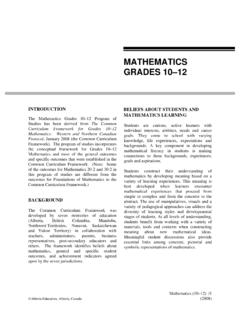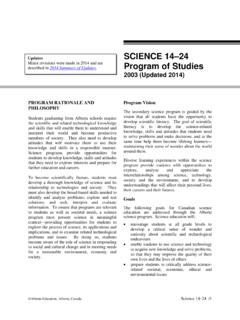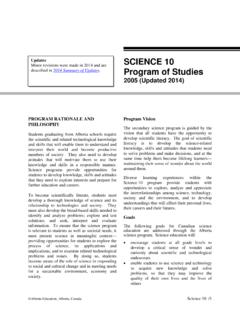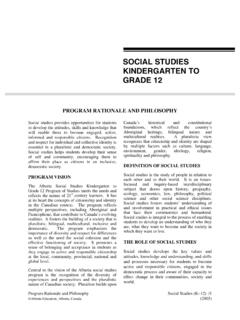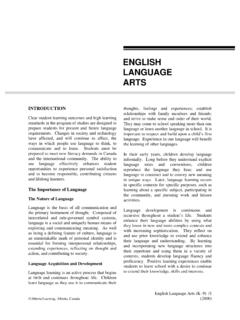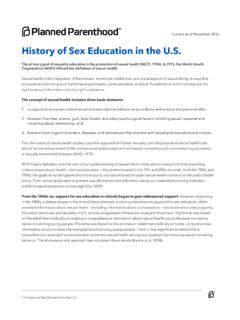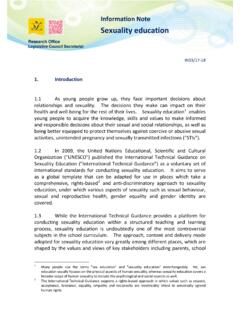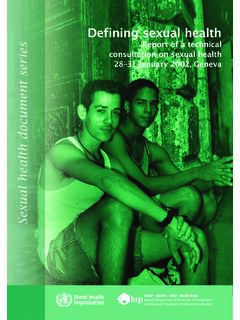Transcription of HEALTH AND LIFE SKILLS KINDERGARTEN TO GRADE 9
1 HEALTH AND life SKILLS . KINDERGARTEN TO. GRADE 9. PROGRAM RATIONALE AND PHILOSOPHY. HEALTH and life SKILLS involves learning about the The aim of the HEALTH and life SKILLS habits, behaviours, interactions and decisions KINDERGARTEN to GRADE 9 Program of Studies is related to healthy daily living and planning for the to enable students to make well-informed, future. It is personal in nature and involves healthy choices and to develop behaviours that abilities based on a body of knowledge and contribute to the well-being of self and others. practice that builds on personal values and beliefs To achieve this aim, students require an within the context of family, school and understanding of self as the basis for healthy community. Some examples of these learnings interactions with others and for career include the ability of students to: development and lifelong learning.
2 Students also require a safe and caring school and community make effective personal decisions for current environment in which to explore ideas and issues and future issues and challenges surrounding personal choice, to seek accurate plan and set goals information, and to practise healthy behaviours. employ critical reflection cope with change and transition Comprehensive School HEALTH manage stress analyze and manage career and HEALTH -related information This HEALTH and life SKILLS program of studies recognize and expand personal SKILLS provides a basis for instruction in schools. To recognize, explore and expand career achieve overall HEALTH goals for students, opportunities and options curriculum connections between services and explore service learning/volunteerism resources within the school and wider community are needed.
3 A comprehensive school HEALTH commit to lifelong learning. approach is desirable. The home, school and community play important A comprehensive school HEALTH model roles in contributing to the healthy personal incorporates: development of students, by providing an opportunity for them to consider information and HEALTH and physical education instruction that acquire, practise and demonstrate strategies for promotes improved commitment to healthy dealing with the challenges of life and living. choices and behaviours Program Rationale and Philosophy HEALTH and life SKILLS (K 9) /1. Alberta Learning, Alberta, Canada (2002). HEALTH and community services that focus on safety and injury prevention promote strategies to HEALTH promotion and provision of appropriate assess risk, to reduce potential harm, and to services to students who need assistance and identify support systems for self and others.
4 Intervention Students learn about products, substances and environments that promote and support behaviours that may be injurious to their HEALTH . behaviours that enhance the HEALTH of students, They also learn strategies to use in unsafe families and school staff. situations. The HEALTH of students is viewed as an integral Students are encouraged to promote and maintain component of a larger system of HEALTH within the HEALTH as a valued and valuable resource, and to home, school and community environment. It examine HEALTH issues and factors that promote or involves the establishment of collaborative limit good HEALTH . They gain an understanding partnerships among students, parents, educators, that, in addition to the effect of their individual HEALTH care professionals and other community behaviours on their HEALTH status, there are social supports to address social and environmental and environmental factors that are beyond their factors that influence and determine optimal immediate control, which also have a significant HEALTH .
5 Impact on their HEALTH . Responsible, Healthy Choices In an environment of acceptance, understanding, respect and caring, students in the HEALTH and life To make responsible and healthy choices, students SKILLS program can learn to acknowledge and need to know how to seek out relevant and express personal feelings and emotions, as well as accurate information. They learn HEALTH -related to appreciate the strengths and talents of self and information from many sources, including home, others. There are opportunities for students to school, peers, the community and the media. The accept and appreciate diversity and the uniqueness HEALTH and life SKILLS program assists students in of self and others in our global society. This identifying reliable sources of information and in program emphasizes healthy interactions and becoming discerning consumers of HEALTH -related values, such as integrity, honesty and trust that information.
6 Students research, evaluate and underlie safe and caring relationships. Friendship synthesize information in an effort to understand SKILLS are developed and then extended to HEALTH issues and to apply the learning to current incorporate SKILLS for working in groups. Such and future personal situations. SKILLS include conflict management, consensus building, negotiation and mediation. Choices, as evidenced by related behaviour, are based on attitudes, beliefs and values. The family Students examine the various sources of stress in is the primary educator in the development of relationships, which include behaviour-related student attitudes and values. The school and factors and those due to natural life cycle changes community play a supportive and crucial role in and transitions. They learn strategies to deal with building on these attitudes and values.
7 Unhealthy relationships, as well as traumatic events. Throughout the program, students build In the HEALTH and life SKILLS program, students and expand upon safe and supportive networks for develop decision-making SKILLS that build self and others that link the home, school and resiliency and self-efficacy, help expand strategies community. for coping, and support informed personal HEALTH practices. Students develop personal Students also develop the SKILLS of goal setting, responsibility for HEALTH , learn to prevent or prioritizing and balancing various roles and reduce risk, and have opportunities to demonstrate life /work priorities. As students develop decision- caring for self and others. making SKILLS , they begin to realize that the locus of control, or their ability to influence or control Students focus on personal and collective safety, many outcomes and results, is within their own as well as injury prevention.
8 Outcomes related to power. 2/ HEALTH and life SKILLS (K 9) Program Rationale and Philosophy (2002) Alberta Learning, Alberta, Canada Through the HEALTH and life SKILLS program, GENERAL OUTCOMES. students acquire a strong foundation of knowledge, SKILLS and attitudes basic to Three general outcomes serve as the foundation employability. Successful careers are founded on for the HEALTH and life SKILLS KINDERGARTEN to a basis of self-knowledge, self-esteem, healthy GRADE 9 Program of Studies. interactions, lifelong learning and skill Wellness Choices development. A fundamental aspect of career education is to move students from being Students will make responsible and informed dependent learners to being independent and choices to maintain HEALTH and to promote interdependent, contributing citizens. Students safety for self and others.
9 Gain confidence and a sense of commitment to family, school and community through Relationship Choices opportunities for participation in cross-age Students will develop effective interpersonal interactions, volunteerism and meaningful SKILLS that demonstrate responsibility, respect involvement in a variety of activities. and caring in order to establish and maintain healthy interactions. Beginning in the early school years, students develop personal and group SKILLS . These are life Learning Choices reinforced as the program expands to include Students will use resources effectively to practical SKILLS directly related to further manage and explore life roles and career education, job seeking and career path opportunities and challenges. exploration. SKILLS related to the management of personal resources, such as time, energy, The general outcomes are interrelated and creativity, money and personal property, are interdependent.
10 Each is to be achieved through a essential elements that build personal capacity and variety of experiences. The emphasis is on overall lead toward future career productivity. well-being. Students learn to enhance attitudes and behaviours that reflect healthy choices and Students build upon the knowledge, SKILLS and reduce the potential for harm. They develop attitudes required to recognize opportunities, personal responsibility for HEALTH , and they critically evaluate options and expand career demonstrate caring for others. strategies to meet current and future challenges. Human Sexuality Education SPECIFIC OUTCOMES. Human sexuality education is offered in GRADE 4 Each general outcome includes specific outcomes to GRADE 9 as a mandatory component of the that students will achieve by the end of each program of studies.
